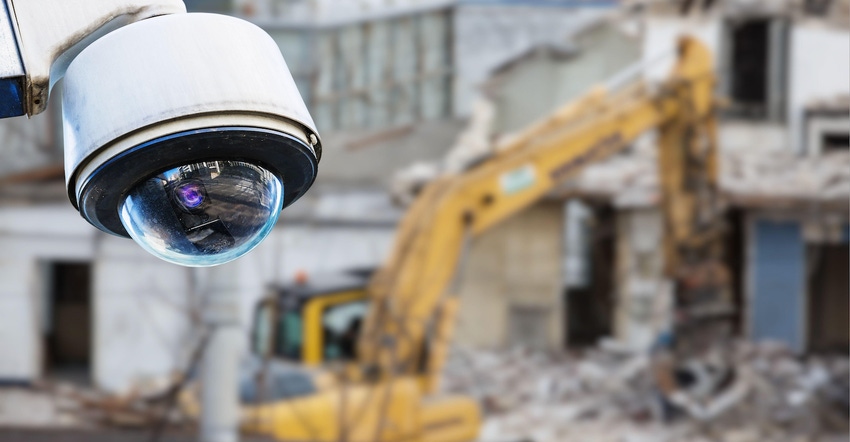Tools and Tips for Preventing Escalating Jobsite Theft
Construction site crimes remain a constant threat for project owners. Here are a few strategies and systems to consider that can elevate your security.
February 9, 2023

Jobsite theft has always plagued the construction industry. But it seems that the problem is only getting worse as material prices continue to climb, the supply chain remains uncertain, inflation takes its toll and the threat of recession creeps in.
According to Amarok, a security systems provider, $1 billion of equipment is stolen annually, and 75% of stolen building materials are never recovered.
One of the most common stolen items is, of course, copper. And the problem isn’t just the loss of the material itself, but the damage thieves inflict to retrieve the wiring—from torn out drywall to dismantled rock crusher cables—which costs even more time and money in repairs and lost productivity.
Along with copper, one of the big-ticket stolen items right now are breaker boxes, which are easily resold, says Lisa Koy, senior account executive for EcamSecure, a provider of surveillance products and monitoring services.
Like breakers, power tools also are easily resold, making them a common item to be stolen.
Equipment theft means higher risk for criminals, but also high reward. Remote jobsites are particularly vulnerable.
Unfortunately, theft isn’t just limited to outside criminals. Employees are just as or more capable of walking off with tools and materials because they have easier access.
How can you reduce jobsite theft?
Preventing—or at least lessening—theft on construction sites is never a one-size-fits-all situation. The site’s size, location, assets and storage all play a role, along with budget, among other factors. Every site and scenario is different. It’s best to consult with a security expert, either independent or through companies offering surveillance equipment and alarms, to help design the best multifaceted approach for your unique jobsites.
Depending on your site, here are a few security tools and best practices to consider.
Cameras and monitoring
Cameras aren’t just recording criminal activity—ideally, their presence is deterring it in the first place. Having visible cameras can often send thieves away to easier targets. (Often, having additional invisible cameras can be important too, in case criminals are brazen enough to ignore and/or damage the visible ones.)
There are a range of options to suit a jobsite’s size and monitoring needs. EcamSecure starts its customers off with a sales consultation, where they walk you through options and help determine how many cameras the site needs, where they should be aimed (such as along perimeters, at storage areas, at entrances, etc.) and other considerations.
The company’s range of monitoring options includes mobile service units (MSUs) that can be installed wherever needed on the jobsite. They come solar powered or can be plugged in and operated wirelessly. EcamSecure’s “virtual guards” monitor the cameras, which are recording 24/7. If a theft is spotted, the virtual guard can call the police and the project owner. The owner also has access to the cameras for both proactive and reactive monitoring.
Along with deterring or recording theft, the cameras also can provide visual documentation for things like workers’ comp claims.
For tighter jobsites, like in urban environments, smaller mobile units or mounted cameras are an option.
Among Samsara’s monitoring systems is artificial intelligence technology that helps streamline workflows and reduce downtime, the company says. Investigation time is reduced with AI-driven search tools, for example, and people/motion/clothing detection reduces passive monitoring.
Tool protection and tracking
Preventing tool theft starts with putting proactive steps in place—protocols for how tools are stored, checked out and checked back in again, as well as ensuring your tool storage is secure and monitored. Leaving tools out and unattended makes it easy for them to wander off with employees or outside criminals.
Be sure to keep documentation for all tools and equipment to help provide proof for insurance. ProToolReviews also suggests engraving your tools with your company’s information, as well as painting tools a bright color to help them stand out if they’re in the wrong hands or out of place.
A growing number of tool management and tracking programs are available. For example, Milwaukee’s One-Key offers cloud-based tool management, providing easy access to view the whereabouts of tools and small equipment. Rooster asset trackers provide GPS tracking along with activity reports for cost comparisons and analysis.
Equipment management and tracking
For trucks, some fleet software systems offer GPS tracking in addition to providing data for management of safety, fuel efficiency and more.
Similar systems are available specifically for heavy equipment. Tenna, for example, offers a unified asset tracking system to manage a blended fleet of equipment, vehicles, tools and consumables. This includes asset management, maintenance, scheduling and more, along with asset tracking.
National Equipment Register’s IRONwatch is a GPS location device that provides location data every eight hours; if activated, it pings consistently. Fleet Complete’s suite of solutions includes a GPS asset tracker for heavy equipment, with 24/7 monitoring and alerts for unauthorized activity.
DeWalt’s MobileLock device can be mounted on storage lockers, heavy equipment and other mobile assets to provide an alarm and GPS tracking.
Fencing and other strategies
Of course, thieves who can’t get onto your site can’t steal from you, which is where fencing and other barriers play a role when possible. As just one example, Amarok offers electric fencing designed for use on construction sites, including portable electric fencing options for projects where the perimeter changes as work progresses.
National Equipment Register offers a number of tips and strategies for helping keep your equipment safe. Here are some suggestions they advise considering:
A high number of false alarms could mean thieves are testing your responsiveness. NER recommends watching for vehicles casing the property.
Test cameras both during the day and at night to ensure the images you’re getting are usable.
Check your fences for tampering to ensure they provide a complete barrier.
Store light or highly targeted equipment in service bays or more secure areas of the site.
Don’t store machines and trucks in areas that provide cover for thieves.
Designate someone to check the facility at different times during a holiday.
NER sends out crime reports for major holidays, which are common times for jobsites to be empty and most vulnerable. For example, in its July 4 report for 2022, the company noted that 320 thefts, valued at more than $7 million, were reported around the holiday over the past five years.
“The July 4th holiday is usually one of the most active periods for equipment theft nationwide, with the high demand for equipment in the summer months,” the report explained. “All areas should consider equipment theft to be a threat just before and over the holiday.”
Whether a holiday or any other day of the year, theft remains one of the biggest challenges for construction project owners. Taking proactive steps, implementing employee protocols and making investments in security equipment can pay off in the long run while providing essential peace of mind.
About the Author(s)
You May Also Like




